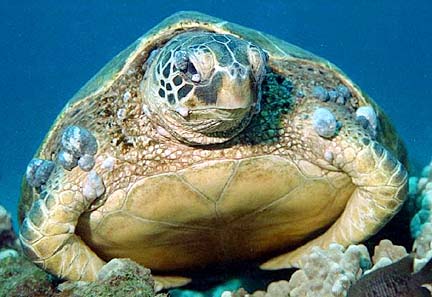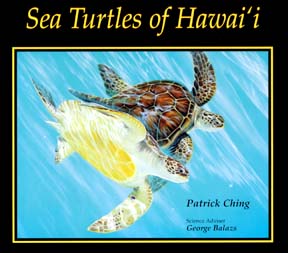


Turtle trauma Laurie McKeon saw her first sea turtles on the beaches of Malaysia. Driven by eons of evolutionary wiring, hundreds of leatherback turtles were desperately crawling ashore on a moonless night, attempting to lay eggs in the warm sands. As soon as the gravid females laid their eggs and crawled back into the sea, Malaysian teenagers dug up their eggs. All of their eggs. That night, on that Malaysian beach, an entire generation of leatherback sea turtles became soup. My god, thought McKeon, this is not ... sustainable.
From Maui to Malaysia, sea turtles
are falling victim to human influence
and a deadly epidemic of tumorsBook imparts fondness for sea turtles
By Burl Burlingame
bburlingame@starbulletin.com

Peter Bennett and Ursula Keuper-Bennett of Canada spend every summer diving in a turtle sanctuary area near Maui dubbed the "Turtle House," and in the process have become lay experts in the narrow field of sea turtle behavior. To the Bennetts, the turtles are individuals, with varied appearances and moods, and they've given the creatures names. They taken hundreds of hours of video, thousands of photographs and reams of observations, an invaluable resource for behavioral scientists.One turtle favorite was Clothahump, a cheerful little fellow who liked to play, and always the first to welcome humans back to the Turtle House. Clothahump, named for a turtle wizard in a fantasy story, darted here and there like a puppy, sleek and flashing beneath the waves.

But the last time the Bennetts saw Clothahump, he was mottled in leaking tumors, billowing out of his skin like yard mushrooms, trailing blood and pus in the water. The turtle had trouble moving, trouble seeing, trouble breathing. He circled his friends once and headed slowly away, into the vast blackness of deep water. He vanished. A videotape Peter Bennett shot of the encounter is shaky, for he was weeping into his face mask.
Something is killing the sea turtles of the world. Man takes his toll, but now there is a type of herpes virus called fibropapillomatosis. First noticed by a handful of sea turtle scientists like Hawaii's George Balazs, the disease has grown exponentially over the last decade, striking simultaneously all over the world.There's an excellent chance, says McKeon, that "this creature that has survived for 100 million years, longer than the dinosaurs, will become extinct in our lifetime."
>> 7:30 p.m. tomorrow at the Waikiki Aquarium, 2777 Kalakaua Ave. Call 923-9741. Free. Osha Gray Davidson to speak
>> 6:30 p.m. Wednesday at the Maui Ocean Center, 192 Ma'alaea Road. Call (808) 270-7085.
>> 7 p.m. Thursday at Kilauea Visitor Center, Hawaii Volcanoes National Park; $1 donation. Call (808) 985-6014 or (808) 985-6011.
Book sales will benefit the Waikiki Aquarium. The Honu Project can be reached at P.O. Box 61449, Honolulu, HI 96839 and at http://www.Hawaii50.com/honu Call 732-4668 or direct email to honuea@lava.net.
McKeon is one of the founders of the Honu Project, an educational consortium dedicated to bringing citizens up to speed on the plight of sea turtles. The nonprofit agency, about a decade old, "concentrates on educational videos rather than political activism -- we'd rather educate a larger audience than alienate a smaller one," explained McKeon.

Fibropapillomatosis, or FP, was just a rare textbook disease when the Honu Projectwas created. There were more pressing concerns. Although sea turtles were on the endangered species lists, they were victims of gillnets, of habitat destruction, of ballooning popularity -- particularly in the Pacific -- as an exotic meal. Some Hawaiians felt they had an aboriginal right to kill sea turtles.
And throughout the world, as beaches became developed and industrialized, the sea turtles' Achilles' heel -- their dependence on laying eggs on land -- became more and more a vulnerability.
"There's so much we still don't know about sea turtles.
The main problem at the moment, however, looming over the species' future like a thundercloud on the horizon, is the mystery disease. The Honu Project and the Waikiki Aquarium are sponsoring a talk and book-signing by science writer Osha Gray Davidson, whose "Fire in the Turtle House" documents the work of dedicated scientists and volunteers to understand FP.
- How do they navigate across thousands of miles of ocean? There are the 'lost years,' between the time the turtles hatch and mature and return as adults -- we don't know where they go," mused McKeon.
We caught Davidson in California. "There's a pathogenic firestorm on the loose," he said. "Clearly, something has changed, and that's the shore waters around the world, and that's our doing. The water has become friendly to diseases, and created a metademic that is creating mass mortality.
"It's not just sea turtles. Other ocean creatures are becoming affected. We're fond of sea turtles, however; they're the ambassadors of the sea, sacred in many cultures. Kupuna Sam Kaai says we're all children of the sea, and he's right. What happens in the sea affects us all, and we understand so little about it.
"Oceans ARE sacred. We need to treat them that way. Everything flows from that. The good news is that if man is doing this to the ocean, then we can undo it."
This is a handsome companion book by author/artist/naturalist Patrick Ching. It focuses on the honu, the Hawaiian green species of sea turtle, although several of the seven species known worldwide pass through Hawaiian waters. "Sea Turtles of Hawai'i" Book imparts fondness for sea turtles
By Burl Burlingame
bburlingame@starbulletin.com
By Patrick Ching (University of Hawaii Press, $16.95)

Ching takes a scrapbook approach, gathering diverse materials from the scientific, Hawaiian and fishing communities.The sea turtle is not only sacred to Hawaiians as aumakua, it was considered good eating as well.
Ching provides a brisk overview of the sea turtle's anatomy.
A section on dangers to this threatened species has a section devoted to the mysteries of fibropapilloma, and sections on the modern fondness for sea turtle conservation shows tourists encountering this most ancient of sea creatures.
The meat of the book, however, is the many splendid color photographs -- many taken by Ching -- and Ching's evocative, naturalistic paintings of the animals.
It's impossible not to become fond of sea turtles after leafing through this book.
Click for online
calendars and events.